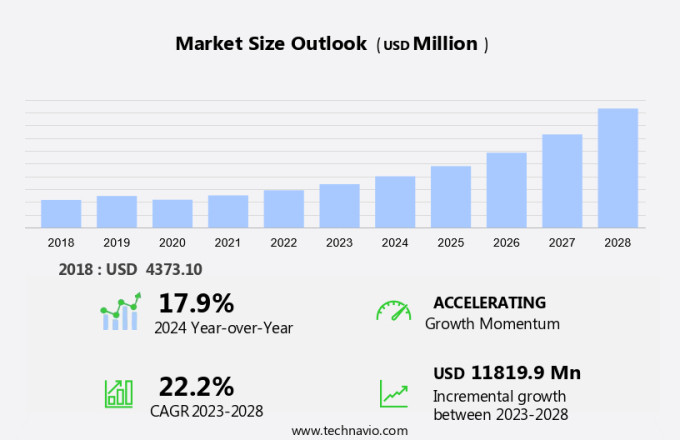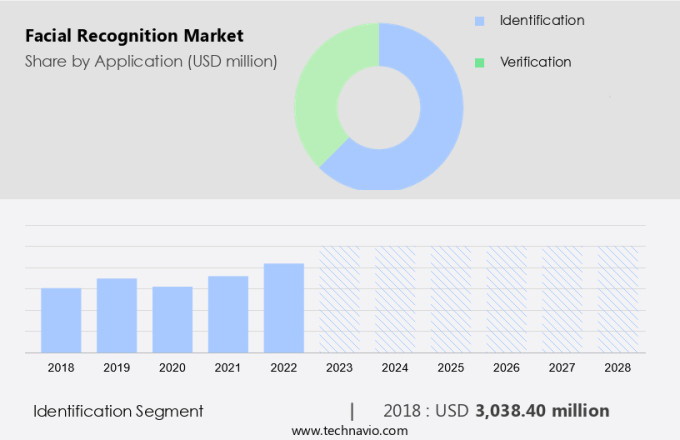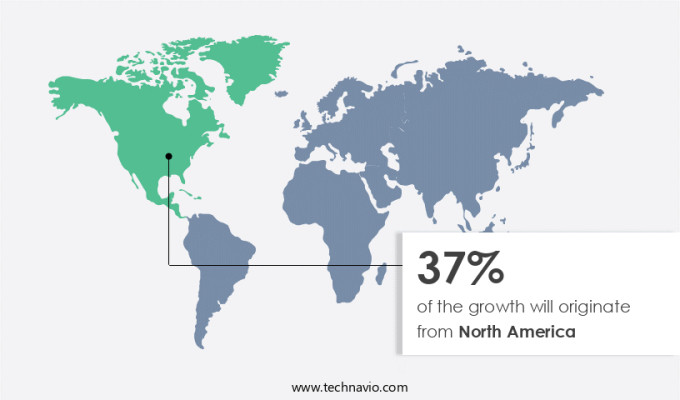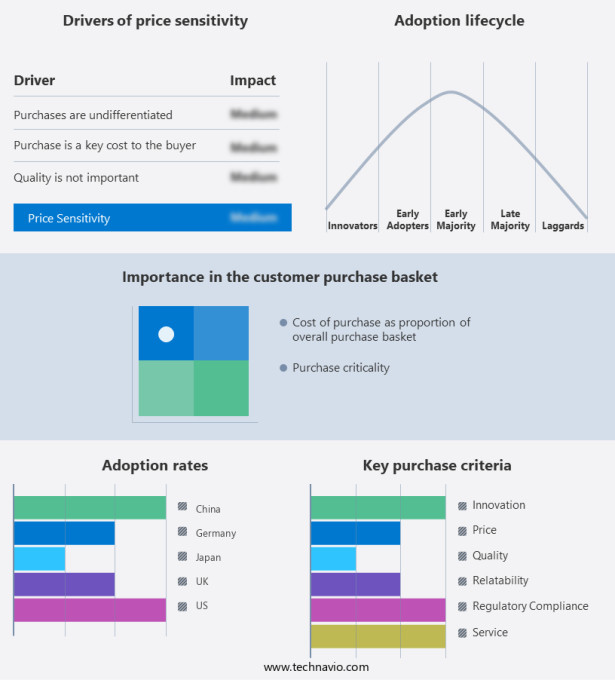Facial Recognition Market Size 2024-2028
The facial recognition market size is forecast to increase by USD 11.82 billion, at a CAGR of 22.2% between 2023 and 2028.
- The market landscape is experiencing substantial growth, leading to a significant increase in demand for advanced identity verification. Organizations are prioritizing security measures, resulting in a rising need for precise and efficient identity verification processes. Key market trends include technological advancements and the emergence of facial analytics, which enhance accuracy and efficiency.
- However, the high cost of deployment remains a significant challenge, potentially limiting access for smaller businesses and organizations. Overcoming this hurdle is essential for fostering broader adoption of digital identity and security and ensuring sustained growth in the market, particularly in the coming years.
- The facial recognition market is expanding, driven by AI facial recognition and biometric authentication technologies. These advancements support security surveillance, contactless identity verification, and emotion detection technology. Cloud-based facial recognition systems leverage video analytics for enhanced public safety applications and access control solutions. However, privacy regulations play a significant role in shaping market growth, ensuring secure and compliant implementation of these systems in various sectors.
What will be the Size of the Facial Recognition Market During the Forecast Period?

To learn more about the facial recognition market report, Request Free Sample
- Facial recognition technology is widely used across sectors like education for attendance, healthcare for patient monitoring, and retail for access control. Biometric POS Terminals integrate facial recognition to enhance payment security and efficiency. This technology also supports banking and law enforcement with secure authentication and surveillance.
- Companies and technology corporations are pioneering advancements in facial recognition and biometric access control systems, employing technologies like image recognition and speech recognition. Facial characteristics, including jawline and facial contours, are analyzed to authenticate individuals. The application of facial recognition technology extends to smart hospitality services, enhancing the overall customer experience. This technology offers enhanced security and efficiency across multiple industries.
How is the Facial Recognition Market Segmented?
The facial recognition market trends and analysis report provides comprehensive data (region-wise segment analysis), with forecasts and estimates in "USD billion " for the period 2024-2028, as well as historical data from 2018 - 2022 for the following segments.
- Application Outlook
- Identification
- Verification
- Technology Outlook
- End-user Outlook
- Media and entertainment
- BFSI
- Automobile and transportation
- Others
- Region Outlook
- Europe
- The U.K.
- Germany
- France
- Rest of Europe
- Middle East & Africa
- Saudi Arabia
- South Africa
- Rest of the Middle East & Africa
By Application
- The market share growth by the identification segment will be significant during the forecast period. Facial recognition technology has emerged as a significant solution for identification and verification in various sectors. NEC Corporation, Microsoft, AWS, and other tech giants are leading the market with advanced facial recognition systems. KYC systems and digital payments are integrating facial recognition for secure authentication. Smartphone applications and physical security systems also utilize this technology for access control and surveillance.

Get a glance at the market share of various regions. Download the PDF Sample
- The identification segment was valued at USD 3.04 billion in 2018. Facial recognition systems use facial features, such as jawline and unique identifiers, to authenticate individuals. These systems are widely adopted in public safety and physical security for identification and verification purposes. The transportation sector, particularly airports, has seen a significant increase in the adoption of facial recognition technology for entry/exit systems.
- Sectors requiring strict access control and video surveillance, such as banking and law enforcement, are increasingly relying on facial recognition technology for identification and verification. Authentication techniques using facial recognition are more secure and efficient compared to traditional methods. The global market for facial recognition technology is expected to grow significantly due to its wide adoption in various sectors.
Regional Analysis

For more insights on the market share of various regions, Download PDF Sample now!
- North America is estimated to contribute 37% to the growth of the global market during the forecast period. Technavio's analysts have elaborately explained the regional trends and drivers that shape the market during the forecast period. The market in North America is experiencing substantial growth during the forecast period, driven by various applications in forensic investigation, criminal identification, and identification verification.
- Advanced technologies, including artificial intelligence, deep learning algorithms, computer vision, and high-resolution cameras, are being adopted at the initial stages of homeland security and defense. Border control is another significant area where facial recognition technology is being implemented to detect identity fraud and ensure secure entry. In the business sector, the BFSI industry is a major contributor to the market's growth due to the importance of secure access management and data security.
- Consumers are also experiencing the benefits of facial recognition technology through contactless authentication techniques on smartphones and other devices. Technological advancements, such as 3D and 2D facial analytics, emotion recognition, and security and surveillance, are expanding the market's scope in retail and e-commerce, media and entertainment, automobile and transportation, IT and telecom, and other industries.
- However, concerns regarding biases and data security remain critical impacting factors that need to be addressed. Facial recognition technology is revolutionizing various sectors, including law enforcement, border control, and access management, by providing faster and more accurate identification. The use of this technology in forensic investigations and criminal identification is helping law enforcement agencies solve crimes more efficiently.
- In the retail and e-commerce sector, facial recognition technology is being used for contactless payment and personalized marketing, enhancing consumer experiences. The media and entertainment industry is using facial recognition technology for emotion recognition and audience analysis, providing insights into viewer behavior and preferences. In the automobile and transportation sector, facial recognition technology is being used for driver identification and vehicle access, improving safety and security.
- The IT and telecom industry is using facial recognition technology for secure access management and identity verification, ensuring data security and preventing unauthorized access. The market's growth is also being driven by the increasing instances of cyberattacks and data theft in enterprises, making facial recognition technology an essential tool for data security. Despite the numerous benefits, facial recognition technology also raises concerns regarding biases and data security.
- Biases in facial recognition algorithms can lead to incorrect identification, particularly for individuals from underrepresented communities. Data security is another critical concern, as facial recognition data is sensitive and can be used for identity theft and other malicious purposes. In conclusion, the market in North America is expected to grow significantly during the forecast period, driven by various applications in forensic investigation, criminal identification, identification verification, border control, access management, consumer experiences, and other industries. However, concerns regarding biases and data security need to be addressed to ensure the ethical and secure use of this technology.
Our researchers analyzed the data with 2023 as the base year, along with the key drivers, trends, and challenges. A holistic analysis of drivers will help companies refine their marketing strategies to gain a competitive advantage.
Facial Recognition Market Driver
- Increasing instances of identity threats is notably driving facial recognition market growth. The reliance of organizations and individuals on digital platforms for various activities, including education, healthcare, retail, and finance, has led to identity and data theft cases. Criminal activities, such as attendance tracking in educational institutions, patient identification in healthcare settings, and automating payment systems in retail sectors, have become increasingly common.
- To mitigate these security threats, there is a growing trend toward implementing advanced authentication solutions, particularly facial recognition technology. This biometric security method offers enhanced security by incorporating the unique physical and behavioral features of end-users, making it difficult to forge. Facial recognition is gaining popularity in various sectors, including education, healthcare, retail, and critical infrastructure, to ensure operational efficiency and security.
- However, the use of facial recognition technology raises privacy concerns, as it involves monitoring public spaces and mobile devices. Organizations must address these concerns while implementing these systems to prevent illegal monitoring and vulnerability to cyber threats, such as deep fakes and camera injection attacks. Despite these challenges, facial recognition technology is expected to continue its growth in areas requiring identity verification, such as app access, device unlocking, and identity verification for mobile payments. However, the technology remains vulnerable to hacking and data breaches, making it essential for organizations to invest in security measures to prevent unauthorized access. Thus, such factors are driving the growth of the market during the forecast period.
Facial Recognition Market Trends
- Technological advances and emergence of facial analytics is the key trend in the market. Facial recognition technology is revolutionizing various sectors, including attendance tracking in organizations, educational institutions, and healthcare settings. In healthcare, this technology is utilized for patient identification and authentication, streamlining processes and enhancing operational efficiency. Retail sectors are leveraging facial recognition for automating payment systems and monitoring customer behavior to optimize marketing strategies.
- Security is a primary concern in airports, critical infrastructure sectors, public spaces, and transportation hubs, where facial recognition is employed to ensure surveillance systems and prevent security threats and criminal activities. Facial recognition capabilities are integrated into video surveillance systems, offering organizations an additional layer of security. These systems can be purchased as standalone solutions or integrated software offerings. In the education sector, facial recognition is used for identity verification and access control in mobile devices and mobile apps.
- In the retail sector, it is employed for mobile payments, app access, and device unlocking. However, the use of facial recognition technology raises privacy concerns, as there is a vulnerability to hacking, deep fakes, cyber threats, data breaches, and unauthorized access. Cameras injected with malware and deepfakes pose significant challenges to identity verification and fraud prevention. It is crucial for organizations to address these concerns and ensure that facial recognition technology is used ethically and responsibly.
- Companies must prioritize privacy and security in their offerings, providing transparency and control to users. The integration of facial recognition technology into various sectors is poised to bring about significant advancements, but it is essential to a balance between security and privacy. Thus, such trends will shape facial recognition market growth during the forecast period.
Facial Recognition Market Challenge
- High cost of deployment is the major challenge that affects the growth of the market. Facial recognition technology has gained significant traction in various sectors, including attendance tracking in educational institutions, patient identification in healthcare settings, and automating payment systems in retail. However, the implementation of this technology comes with substantial costs, making it a challenge for organizations in sectors such as education, healthcare, and retail to adopt it on a large scale. The costs extend beyond the purchase price, encompassing maintenance, middleware, and other associated expenses.
- Despite the challenges, facial recognition technology offers numerous benefits, such as operational efficiency, enhanced security, and improved monitoring in critical infrastructure sectors like airports, power plants, and transportation hubs. In public spaces, facial recognition technology can help mitigate security threats and prevent criminal activities. In addition, it can be used for authentication and identity verification in mobile devices, app access, and device unlocking. However, the adoption of facial recognition technology also raises privacy concerns.
- Unauthorized use and illegal monitoring can lead to data breaches, cyber threats, and vulnerability to hacking. Deep fakes and camera injection attacks pose additional risks, making it crucial for organizations to implement security measures and adhere to ethical guidelines. Despite these challenges, the market for facial recognition technology is expected to grow significantly, driven by the increasing demand for authentication and security in various sectors. The technology's ability to prevent fraud and ensure identity verification makes it an essential tool for organizations looking to enhance their security and operational efficiency. Hence, the above factors will impede facial recognition market growth during the forecast period.
Customer Landscape
The facial recognition market forecasting report includes the adoption lifecycle of the market, covering from the innovator's stage to the laggard's stage. It focuses on adoption rates in different regions based on penetration. Furthermore, the facial recognition market research and growth report also includes key purchase criteria and drivers of price sensitivity to help companies evaluate and develop their market growth analysis strategies.

Customer Landscape
Which are the Key Market Companies?
Companies are implementing various strategies, such as strategic alliances, partnerships, mergers and acquisitions, geographical expansion, and product/service launches, to enhance their presence in the market.
Amazon.com Inc. - The company offers facial recognition solutions such as Content moderation, Face compare and search, and Face detection and analysis.
The facial recognition market growth and forecasting report also includes detailed analyses of the competitive landscape of the market and information about key companies, including:
- ASSA ABLOY AB
- Aware Inc.
- Ayonix Pty Ltd.
- Cognitec Systems GmbH
- Daon Inc.
- Facebanx
- FaceFirst Inc.
- Fujitsu Ltd.
- IDEMIA France SAS
- Ipsidy Inc.
- Luxand Inc.
- Microsoft Corp.
- NEC Corp.
- Precise Biometrics AB
- Safran SA
- Suprema Inc.
- Synaptics Inc.
- Thales Group
- Veridium IP Ltd.
Qualitative and quantitative analysis of companies has been conducted to help clients understand the wider business environment as well as the strengths and weaknesses of key market players. Data is qualitatively analyzed to categorize companies as pure play, category-focused, industry-focused, and diversified; it is quantitatively analyzed to categorize companies as dominant, leading, strong, tentative, and weak.
What are the Latest Market Developments and News?
-
In December 2024, Microsoft expanded its facial recognition technology to enhance security systems in government buildings and public spaces. The technology integrates advanced AI to improve accuracy and prevent unauthorized access, while addressing privacy concerns through user consent protocols.
-
In November 2024, NEC Corporation introduced a new facial recognition system designed for retail and banking sectors. The system is capable of identifying customers for personalized services and fraud prevention, helping businesses streamline operations and enhance the customer experience.
-
In October 2024, Amazon Web Services (AWS) launched a new facial recognition tool as part of its cloud AI services, targeting public safety and security applications. The tool promises improved identification accuracy even in crowded or low-light environments, offering new opportunities for law enforcement.
-
In September 2024, Face++ partnered with a major airport in Europe to deploy facial recognition technology for seamless passenger check-in and boarding. The system aims to reduce wait times and enhance security by providing quicker identity verification at various checkpoints.
Will Technology Innovations Drive Market Growth?
- Facial recognition technology has gained significant attention in various industries, including security, healthcare, and marketing. The market is expanding as advancements in artificial intelligence and machine learning enable more accurate and efficient identification. This technology offers benefits such as improved security, contactless identification, and enhanced customer experience.
- The market is driven by increasing demand for security and surveillance systems as well as personal safety tracking devices, growing adoption in the healthcare sector for patient identification, and rising usage in retail and marketing applications. Additionally, the integration of facial recognition technology in smartphones and other consumer devices is fueling market growth.
- Facial recognition technology utilizes advanced algorithms to analyze and differentiate facial features, providing enhanced accuracy and reliability compared to traditional identification methods. This technology is becoming increasingly accessible and affordable, making it an attractive option for businesses and organizations of all sizes. The future of facial recognition holds significant promise, with potential applications spanning sectors such as border control, law enforcement, and education.
- Artificial intelligence (AI) facial recognition and biometric authentication are revolutionizing the facial recognition market. These technologies enhance security surveillance and contactless identity verification. Furthermore, the integration of emotion detection technology and cloud-based facial recognition is driving the demand for video analytics in public safety applications and access control solutions. Adherence to privacy regulations is crucial to ensure data protection and compliance across industries.
- As the technology advances, we can expect the emergence of even more innovative uses and implementations. The market for facial recognition is expanding steadily due to its numerous applications and benefits. The technology's precision, efficiency, and affordability make it an indispensable tool for businesses and organizations across various industries.
|
Market Scope
|
|
Report Coverage
|
Details
|
|
Page number
|
196
|
|
Base year
|
2023
|
|
Historic period
|
2018 - 2022
|
|
Forecast period
|
2024-2028
|
|
Growth momentum & CAGR
|
Accelerate at a CAGR of 22.2%
|
|
Market growth 2024-2028
|
USD 11.82 billion
|
|
Market structure
|
Fragmented
|
|
YoY growth 2023-2024(%)
|
17.9
|
|
Regional analysis
|
North America, Europe, APAC, Middle East and Africa, and South America
|
|
Performing market contribution
|
North America at 37%
|
|
Key countries
|
US, China, UK, Germany, and Japan
|
|
Competitive landscape
|
Leading Companies, Market Positioning of Companies, Competitive Strategies, and Industry Risks |
|
Key companies profiled
|
Amazon.com Inc., ASSA ABLOY AB, Aware Inc., Ayonix Pty Ltd., Cognitec Systems GmbH, Daon Inc., Facebanx, FaceFirst Inc., Fujitsu Ltd., IDEMIA France SAS, Ipsidy Inc., Luxand Inc., Microsoft Corp., NEC Corp., Precise Biometrics AB, Safran SA, Suprema Inc., Synaptics Inc., Thales Group, and Veridium IP Ltd.
|
|
Market dynamics
|
Parent market analysis, Market growth inducers and obstacles, Market analysis and report, Fast-growing and slow-growing segment analysis, Market growth and Forecasting, COVID 19 impact and recovery analysis and future consumer dynamics, Market condition analysis for market forecast period
|
|
Customization purview
|
If our facial recognition market report has not included the data that you are looking for, you can reach out to our analysts and get segments customized.
|
Download PDF Sample
What are the Key Data Covered in this Facial Recognition Market Research Report?
- CAGR of the market during the forecast period
- Detailed information on factors that will drive the market growth and forecasting between 2024 and 2028
- Precise estimation of the size of the market and its contribution of the market in focus to the parent market
- Accurate predictions about upcoming market growth and trends and changes in consumer behaviour
- Growth of the market across North America, Europe, APAC, Middle East and Africa, and South America
- Thorough analysis of the market's competitive landscape and detailed information about companies
- Comprehensive analysis of factors that will challenge the growth of market companies
We can help! Our analysts can customize this facial recognition market research and growth report to meet your requirements.
Get in touch
Research Framework
Technavio presents a detailed picture of the market by way of study, synthesis, and summation of data from multiple sources. The analysts have presented the various facets of the market with a particular focus on identifying the key industry influencers. The data thus presented is comprehensive, reliable, and the result of extensive research, both primary and secondary.
 INFORMATION SOURCES
INFORMATION SOURCES
Primary sources
- Manufacturers and suppliers
- Channel partners
- Industry experts
- Strategic decision makers
Secondary sources
- Industry journals and periodicals
- Government data
- Financial reports of key industry players
- Historical data
- Press releases

 DATA ANALYSIS
DATA ANALYSIS
Data Synthesis
- Collation of data
- Estimation of key figures
- Analysis of derived insights
Data Validation
- Triangulation with data models
- Reference against proprietary databases
- Corroboration with industry experts

 REPORT WRITING
REPORT WRITING
Qualitative
- Market drivers
- Market challenges
- Market trends
- Five forces analysis
Quantitative
- Market size and forecast
- Market segmentation
- Geographical insights
- Competitive landscape







![]() Get the report (PDF) sent to your email within minutes.
Get the report (PDF) sent to your email within minutes.
Complimentary full Excel data with your report purchase.